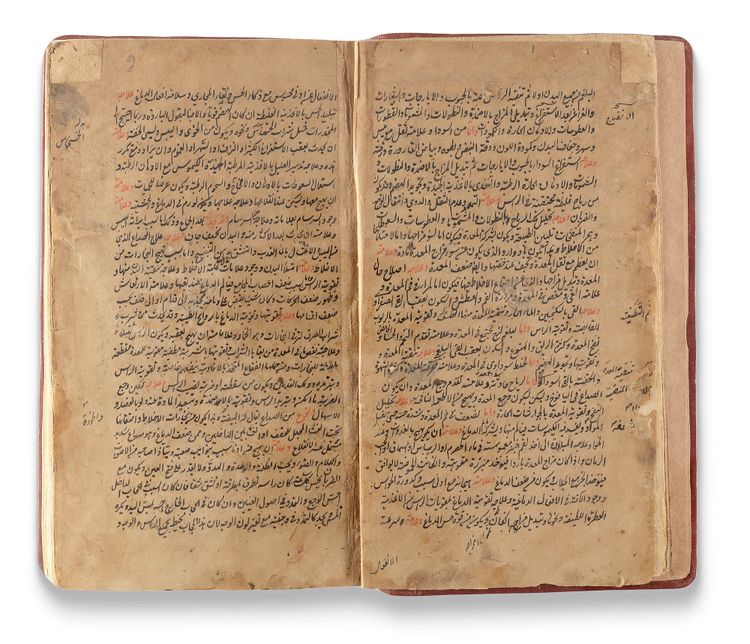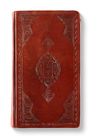Lot 17 THREE CLASSICAL MEDICAL TREATISES: IBN AL-NAFIS, AL-SIQILLI, AND AL-LAHIJI
Arabic manuscript on paper, each page written in 25 lines of black ink, with titles and catchwords in red ink. Housed in deep red leather binding.
Dimensions: 14 by 24 cm.
This volume contains three treatises:
1. The Second Half of the Practical Section of Al-Mujiz fi al-Qanun by Ibn al-Nafis
Diseases of Specific Organs: A head-to-toe survey covering the brain, senses, chest, abdomen, genitals, and limbs. Each section outlines causes, symptoms, and treatments.
General Diseases: Illnesses not confined to a single organ, such as fevers, systemic disorders, and epidemic conditions.
Boils, Wounds, and Epidemics: Guidance on managing ulcers, abscesses, and traumatic wounds, with notes on antiseptics, sutures, and epidemic control.
Fractures, Dislocations, and Injuries: Orthopedic practice, including recognition and treatment of fractures, contusions, sprains, and dislocations, with methods of reduction and splinting.
Hair Disorders: Medical and cosmetic issues of the hair, including causes of loss and greying, with dietary and topical remedies.
Poisons and Antidotes: A section on toxicology—identification of poisons, clinical signs of poisoning, protective regimens, and preparation of antidotes.
2. Al-Adwiya al-Mufrada (“Simple Drugs”)
By Abu al-‘Abbas Ahmad ibn Abd al-Salam al-Sharif al-Husayni al-Siqilli al-Tunisi (d. ca. 820 AH / 1416 AD), a Sicilian-born Tunisian scholar and physician who studied medicine at the University of al-Zaytuna in Tunis and later served at the Bimaristan (hospital) built by the Hafsid Sultan Abu Fāris Abd al-‘Aziz.
Arranged in 20 chapters, the work proceeds from the head down to the feet.
Essentially a lexicon of simple remedies, in contrast to complex compound medicines.
In the introduction, the author explains his preference for simple and accessible remedies, as compound prescriptions are difficult to prepare, hard to verify, and seldom used in practice.
The work is also known under the title Mufradāt al-Siqillī (“The Simple Drugs of al-Siqilli”).
3. Treatise on Fevers by Ahmad ibn Muhammad al-Lahiji
Presented in 22 chapters, this work offers a systematic exploration of fevers in their various forms.
يحتوي هذا المجلد على ثلاثة رسائل طبية:
1. النصف الثاني من القسم العملي من كتاب "الموجز في القانون" لابن النفيس
أمراض الأعضاء الخاصة: دراسة شاملة من الرأس إلى القدمين تشمل الدماغ، الحواس، الصدر، البطن، الأعضاء التناسلية، والأطراف. يوضح كل قسم الأسباب والأعراض وطرق العلاج.
الأمراض العامة: الأمراض غير المحصورة في عضو واحد، مثل الحمى، الاضطرابات الجهازية، والأوبئة.
الدمل والجروح والأوبئة: إرشادات لإدارة القروح والخراجات والجروح الناتجة عن الإصابات، مع ملاحظات حول المطهرات والخياطة ومكافحة الأوبئة.
الكسور والخلوع والإصابات: الممارسة العظمية، بما في ذلك التعرف على الكسور والكدمات والالتواءات والخلوع وعلاجها، مع طرق التثبيت والتجبير.
مشاكل الشعر: القضايا الطبية والتجميلية للشعر، بما في ذلك أسباب التساقط والشيب، مع العلاجات الغذائية والموضعية.
السموم والترياق: قسم عن علم السموم — تحديد السموم، العلامات السريرية للتسمم، الإجراءات الوقائية، وإعداد الترياق.
2. الأدوية المفردة (Al-Adwiya al-Mufrada)
لأبي العباس أحمد بن عبد السلام الشريف الحسيني الصقلي التونسي (توفي حوالي 820 هـ / 1416 م)، عالم وطبيب تونسي من أصل صقلي، درس الطب في جامعة الزيتونة بتونس وعمل لاحقًا في البيمارستان الذي بناه السلطان الحفصي أبو فارس عبد العزيز.
مقسَّم إلى 20 فصلًا، يبدأ من الرأس وينتهي عند القدمين.
في الأساس معجم للأدوية البسيطة، على عكس الأدوية المركبة المعقدة.
في المقدمة، يوضح المؤلف سبب تركيزه على الأدوية البسيطة والمتاحة، لأن الوصفات المركبة صعبة التحضير، ويصعب التحقق من صحتها، ونادرًا ما تُستخدم في الممارسة العملية.
يُعرف هذا الكتاب أيضًا بعنوان مفردات الصقلي.
3. رسالة عن الحمى لأحمد بن محمد اللحيجي
مقدمة في 22 فصلًا، تقدم دراسة منهجية للحمى بأشكالها المختلفة.




